As a pet owner, nothing is more heart-wrenching than losing a beloved furry family member. That sinking feeling when your dog or cat goes missing can leave you feeling helpless and distressed. This is why I highly recommend microchipping pets—a permanent, reliable, and safe method to ensure your companion’s identity stays with them no matter what. In this article, I’ll take you on a comprehensive journey through the world of pet microchipping, sharing everything you need to know—from how it works and its undeniable benefits to practical steps for implantation, registration, maintenance, and even breed-specific considerations. If you’re a family seeking guidance on pets, breeds, and training, you’ll find actionable advice and expert insights here that can make a real difference in safeguarding your pet’s future.
By the end, you’ll appreciate why microchipping pets is more than just a trend—it’s a smart, responsible decision rooted in science, safety, and love. Let’s dive in!
Understanding Microchipping: A Permanent Solution for Pet Identification
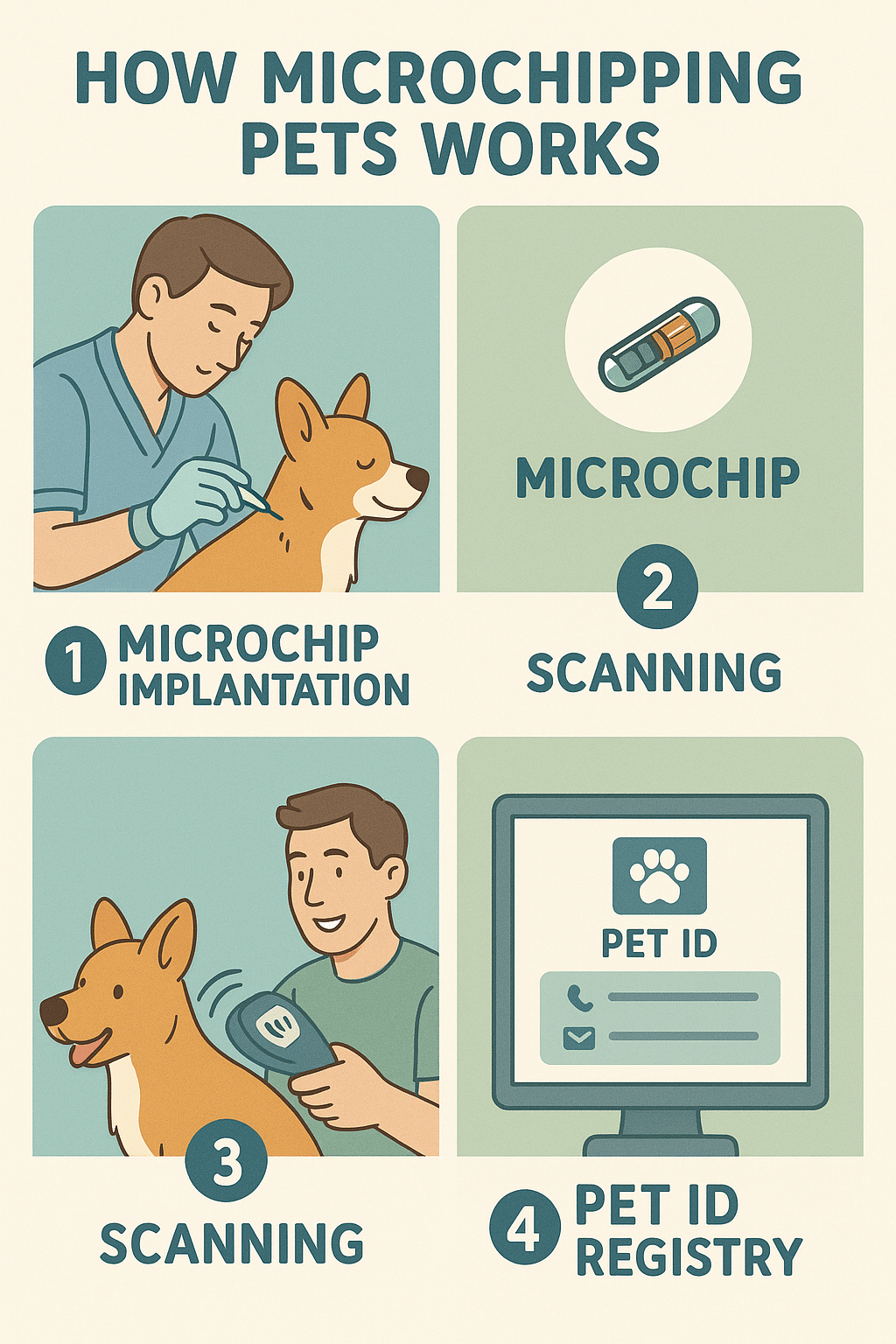
What Is a Microchip and How Does It Work?
A microchip, in the context of pets, is a tiny, rice-sized implantable device that holds a unique identification number. This ID number is stored securely in a computer chip, embedded under your pet’s skin—usually between the shoulder blades. What amazes me as a vet professional is how such a minuscule implant can make such a significant impact.
Here’s how it works: when your pet is scanned with a special microchip reader, the device displays the ID number embedded in the chip. This number corresponds to your registration details stored in a microchip registry database. So, if your pet is found by animal control, shelters, or veterinary clinics, the staff can quickly scan your pet and access your contact information, enabling a swift reunion.
The microchip itself contains no GPS or tracking capabilities. It’s simply an identification tag—permanent and tamper-proof.
How Microchips Differ from Traditional Identification Methods
You’ve probably seen dogs and cats wearing collars with ID tags, or maybe you’ve used GPS tracking devices to keep tabs on your pet’s location. While these tools play important roles, they do have limitations.
Collars and ID Tags: Necessary but Not Sufficient
Collars and tags are the first line of defense for pet identification. They are visible, easy to update, and convenient for walkers or neighbors to spot. However, collars can break, get lost, or be removed—especially during escapes or accidents. For example, a loose collar can slip off, and relying on tags alone may mean precious time is lost in identifying your pet.
Limitations of GPS Trackers Compared to Microchips
GPS trackers are fantastic for monitoring your pet’s real-time location. However, they depend on batteries, cellular signals, and can have subscription fees. GPS devices can fail or run out of power during critical moments. Moreover, they are often bulky or require additional collars, which might not be suitable for smaller pets.
By contrast, a microchip is a lifetime implant —it never needs charging, can’t be lost or removed by your pet, and serves as a permanent ID embedded right inside. Think of microchips as the bedrock of pet identification, complementing rather than replacing collars and trackers.
The Top 5 Benefits of Microchipping Pets
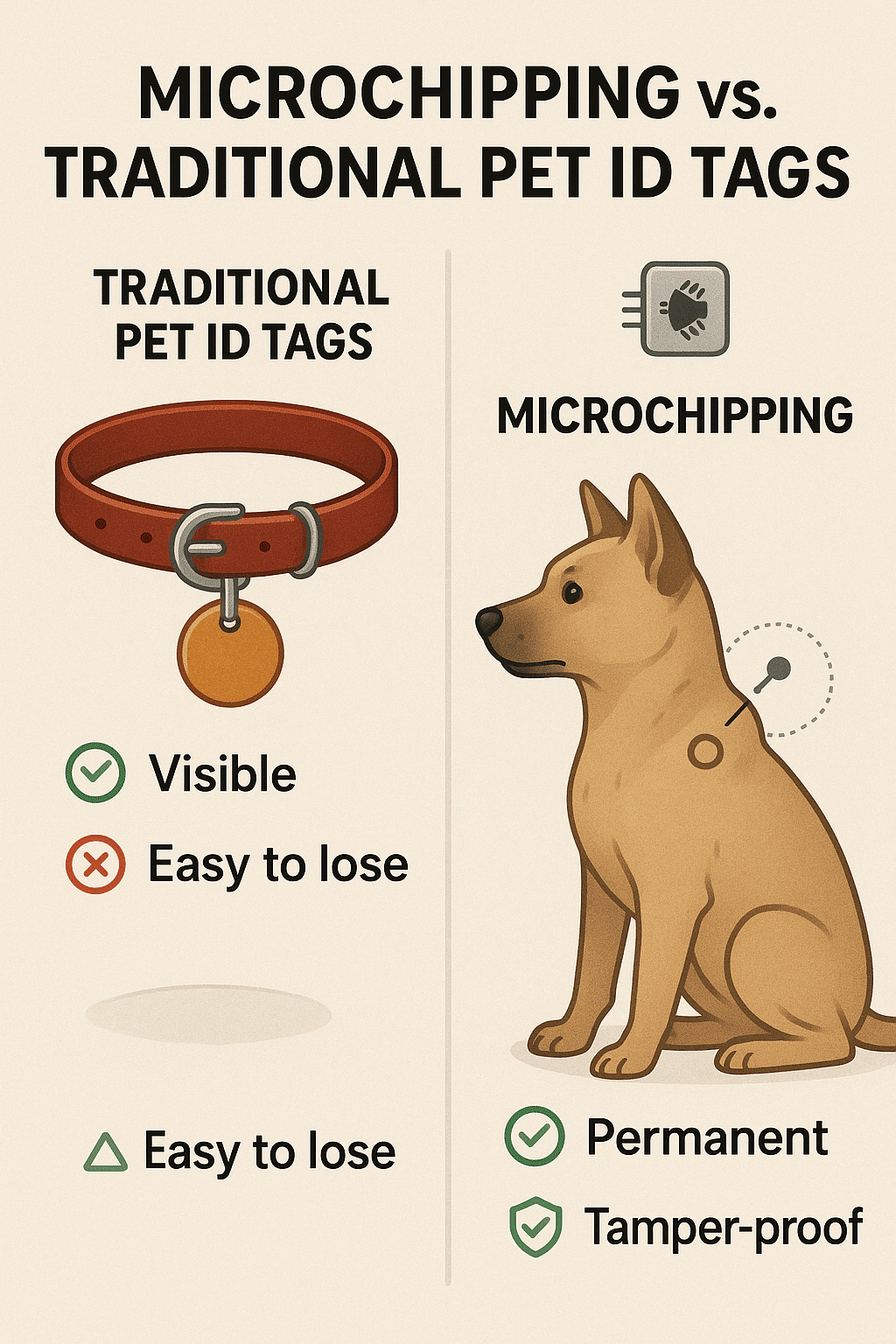
Permanent Identification That Cannot Be Lost or Removed
The core advantage of microchipping pets lies in permanence. Unlike collars or tags, microchips stay with your pet for life once implanted. This biocompatible chip is designed to be safe and stable under the skin. Even if your pet sheds collars or breaks tags, the chip remains intact, providing an unbreakable link to your contact information.
This permanence is critical because it means your pet’s identity cannot be separated from them—dramatically reducing the chance your pet will end up at a shelter with no way to trace you.
Significantly Increased Chances of Pet Recovery
Statistics prove what many pet owners (myself included) have experienced firsthand: microchipped pets are far more likely to be reunited with their families.
For example, a study from the American Veterinary Medical Association (AVMA) reported that approximately 52% of lost microchipped dogs and 38% of lost microchipped cats were returned to their owners versus 21% and 2% for unchipped pets, respectively. When every minute counts in an emotionally traumatic event, that extra edge in pet recovery is invaluable.
Long-Lasting and Safe Biocompatible Implants
Microchips are made from biocompatible materials like medical-grade glass or polymer that do not degrade or cause adverse reactions inside your pet’s body. The safety record is exemplary, and they are designed to remain stable for many years—essentially the lifetime of your pet.
Veterinarians across the globe routinely recommend microchips due to their minimal risks and high benefits. Microchip implantation is backed by scientific research that demonstrates their safety and effectiveness over decades.
Ease and Speed of the Implantation Procedure
If you’re worried about the procedure’s complexity or your pet’s comfort, you’ll be relieved to know the implantation is quick, simple, and minimally invasive.
Using a sterile needle and syringe device, the vet inserts the microchip under the loose skin on your pet’s neck. Most pets experience only slight discomfort similar to a vaccination. The whole process takes just a few seconds to perform, and no anesthesia is required.
It’s a bit like receiving a regular vaccination shot but with benefits that last a lifetime.
Integration with National and Local Lost and Found Pet Databases
After implantation, your pet’s unique chip number is registered with a microchip registry that connects to national and local lost pet databases. This creates a crucial network of information that shelters, vets, and animal control can access if your pet goes missing.
In many regions, microchips are linked to centralized databases like the HomeAgain Registry, Avid, or the AKC Reunite program—recognized and trusted platforms that facilitate rapid owner notification.
Microchipping Pets: Step-by-Step Procedure for Owners
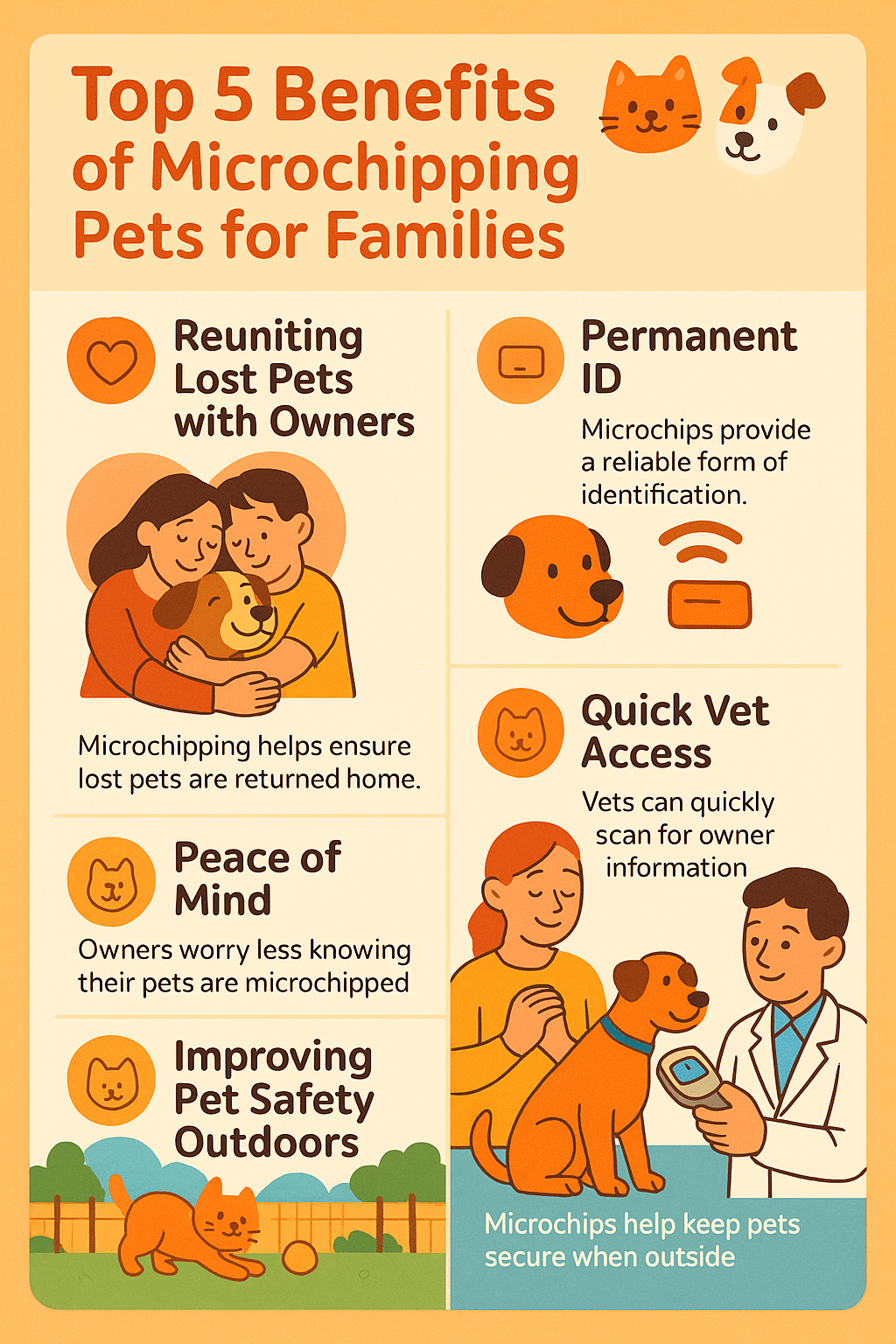
Preparation Before Microchipping Your Pet
Before you head to the vet, it’s helpful to prepare your pet and yourself. Make sure your pet is calm and comfortable. Bring their medical records and previous identification details.
Discuss any concerns with your veterinarian, such as your pet’s size, breed, or health status. This helps ensure the procedure goes smoothly.
Make sure to ask about the type of microchip and registry options your vet recommends. Not all microchips or registries are the same in terms of compatibility and coverage.
What to Expect During Implantation at the Veterinarian’s Office
During your appointment, the vet or trained technician will gently restrain your pet and implant the microchip subcutaneously. The process is over in seconds.
Immediately afterward, the vet will scan your pet with a handheld scanner to confirm the chip’s functionality and provide you with the unique identification number. You’ll receive paperwork to register the chip and instructions for next steps.
Aftercare Tips and Monitoring for Any Side Effects
Post-implantation care is minimal. Observe the injection site for redness, swelling, or irritation for a few days. Such reactions are uncommon but should be reported if persistent.
Keep your pet calm, avoiding rough play for 24 hours. Routine activity can resume shortly after.
Registering and Maintaining Your Pet’s Microchip Information
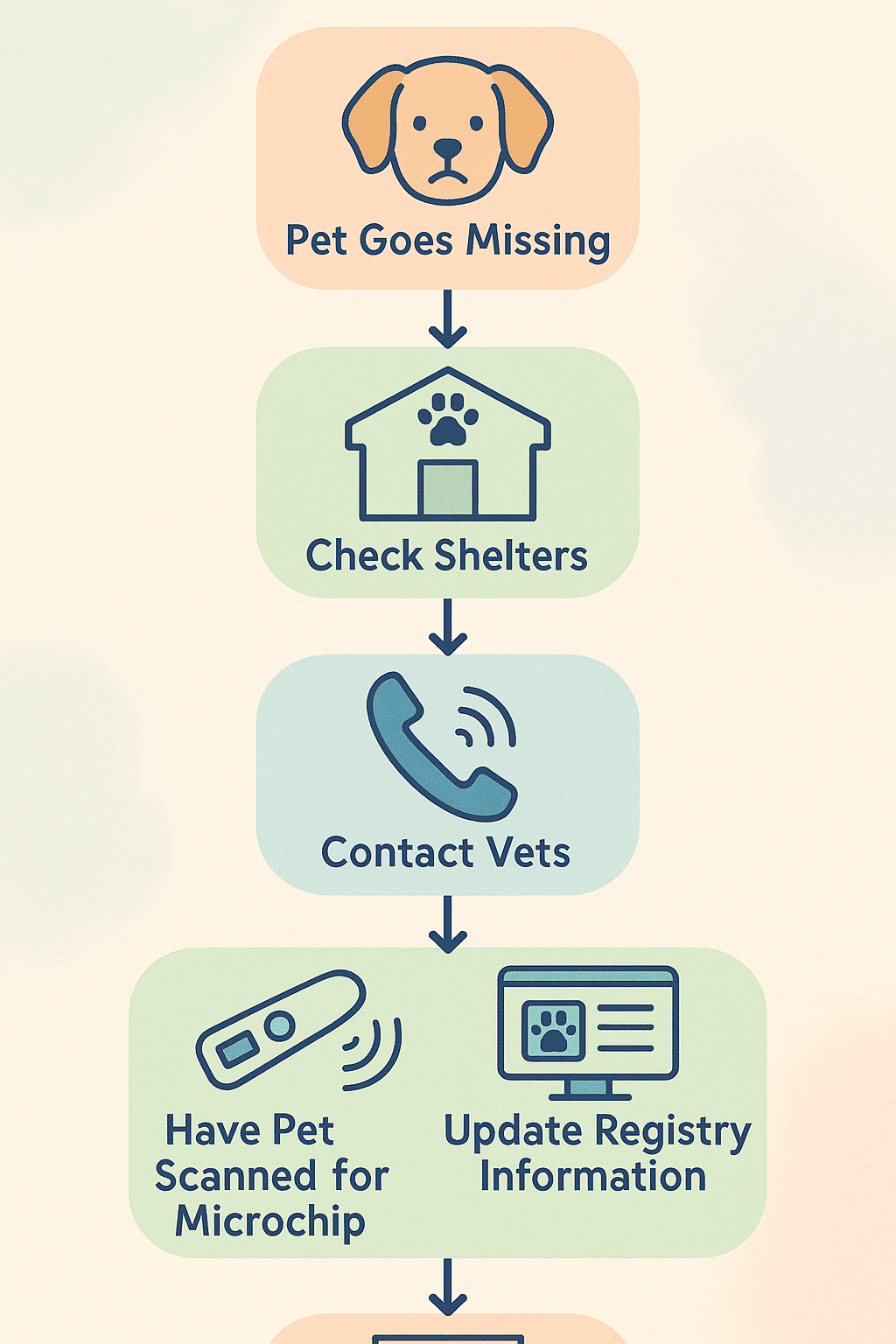
Choosing the Best Animal Microchip Registry for Your Pet
Once implanted, registering your pet’s microchip with a reputable registry is critical. Some popular registries include:
- HomeAgain — Offers nationwide coverage and lost pet recovery services.
- AKC Reunite — High recognition, especially for dog owners.
- AAHA Universal Pet Microchip Registry — Good for verifying microchip info across registries.
Selecting the right registry means your contact data is accessible when needed.
How to Properly Register Your Pet’s Microchip
Registering involves providing current and accurate contact info such as phone numbers, addresses, and emergency contacts. This is often done online or via mail using provided forms.
Be thorough. The more details you provide, the easier pet recovery agencies can reach you promptly.
Updating Owner Information: Why and How it Impacts Pet Recovery
One common oversight is neglecting to update your microchip information after changes like moving or new phone numbers. Outdated records can thwart reunions since rescuers won’t contact the right person.
Most registries allow online updates, so mark a reminder to check and refresh your data annually or whenever you move. It’s a simple habit that can make the difference between finding your pet or losing them forever.
Breed-Specific Considerations for Microchipping Pets
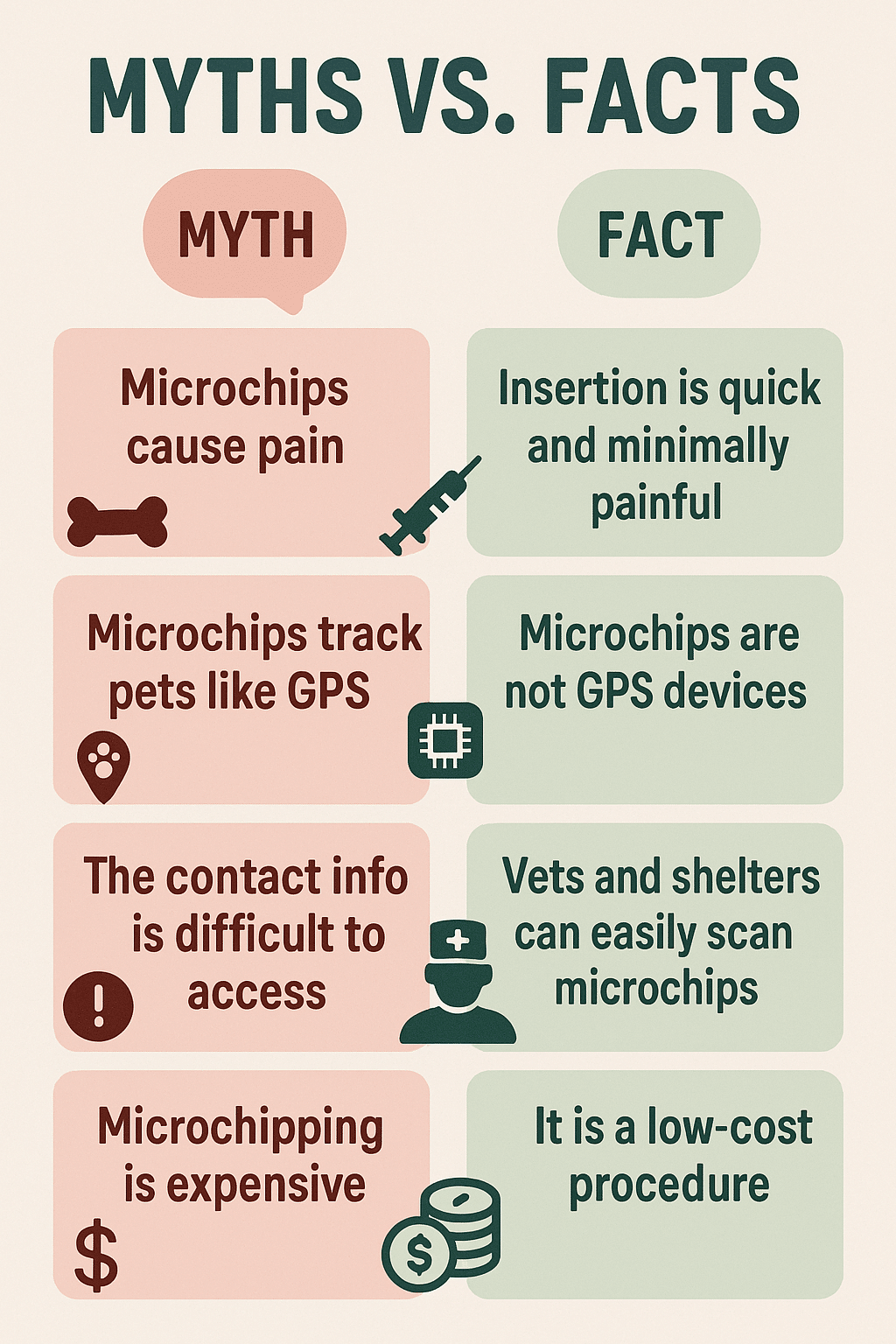
Are Microchips Safe for Small Dog Breeds and Kittens?
Some owners worry about implanting microchips in small or toy breeds and kittens due to their size. Rest assured, microchips are generally safe for all breeds and ages.
Vets use microchips sized appropriately for such small pets, sometimes opting for the smaller half-duplex chips that are equally effective. The implant site and technique may vary slightly for delicate animals.
Microchipping Puppies and Kittens: Timing and Best Practices
I recommend microchipping puppies and kittens as early as 6 to 8 weeks of age, often during their first veterinary visits for vaccinations. Early microchipping ensures identification from day one, especially important for breeders and shelters.
However, ensure the animal is healthy and has plenty of skin for safe implantation. Your veterinarian will advise on the best timing and approach.
Complementary Pet Identification and Training Techniques
Training Your Pet to Wear Collars with Identification Tags
Although microchips are permanent, visible ID aids are invaluable. Training your pet early to wear a comfortable collar with identification tags is a great habit.
Start with lightweight collars that fit snugly but not tightly, allowing adaptations to wear. Positive reinforcement techniques—like treats and praise—help pets accept collars happily.
Combining Microchipping and Traditional ID Methods for Maximum Safety
The best safety net involves combining microchips with collars and tags. This layered approach covers all bases—visible ID for immediate identification and microchips as the failsafe.
If your pet escapes or collars get lost, the microchip remains the ultimate safety net.
Addressing Behavioral Concerns Related to Microchipping and Identification
Some owners worry microchipping or collars may affect pet behavior. From experience and scientific studies, the microchip implant itself doesn’t alter behavior—it’s minimally invasive and barely noticeable to pets.
However, collars may cause discomfort if incorrectly fitted or attached too tightly. Always monitor your pet for signs of stress and make adjustments accordingly.
Legal Requirements and Regulations for Microchipping Pets
Overview of State and Local Laws on Pet Microchipping
Many states and municipalities now require microchipping for pet licensing, shelter adoptions, or during resale and transfers. These laws aim to improve pet recovery and reduce abandonment.
Check your local animal control or government websites to understand specific requirements and deadlines. Compliance not only keeps you legal but protects your pet.
Responsibilities for Breeders Regarding Microchipping Puppies
Breeders, too, face regulations mandating microchipping puppies before sale or adoption in several regions. This ensures buyers receive pets already protected.
If you’re a breeder or considering purchasing a puppy or kitten, verify the microchip status and registry to avoid surprises.
What to Do If Your Pet Goes Missing: Leveraging Microchip Technology
Steps to Take Immediately After Your Pet Is Lost
If your furry friend goes missing, act fast:
- Notify local shelters, vets, and animal control offices. Provide descriptions and your pet’s microchip number if possible.
- Use social media and community bulletin boards to spread the word.
- Contact your microchip registry and ensure your contact info is current.
- Put up flyers around your neighborhood and favorite park areas.
Having a microchip means shelters scanning your pet will find your info fast.
How Lost Pet Shelters and Rescue Organizations Use Microchip Data
Shelters and rescues routinely scan incoming animals for microchips. Once identified, they contact you based on registry details. This bypasses lengthy adoption hold times or mistaken shelter stays.
Many shelter workers attest to microchips being the pivotal tool that reunites lost pets with families quickly.
Comparing Microchipping to Emerging Pet Tracking Technologies
Benefits and Drawbacks of GPS Trackers Versus Microchips
GPS trackers offer real-time location tracking, but they require batteries, ongoing costs, and may fail in low-signal areas. Microchips offer indefinite, no-maintenance ID but no live tracking.
Both have strengths, but microchips remain the universal identification gold standard.
How Microchips Complement Pet Tracking Devices
Using microchips in tandem with GPS devices is a winning combo. GPS solves location tracking, while microchips handle permanent identification. This holistic approach maximizes your pet’s safety.
Unique Insight: The Psychological Impact of Microchipping on Pet Owners and Families
Enhancing Peace of Mind and Family Security with Permanent Identification
I’ve worked with many families who share the relief and confidence microchipping brings. Knowing your pet has permanent ID embedded helps you relax during walks, vacations, or emergencies.
It reduces anxiety and empowers owners to act decisively if their pet goes missing.
Encouraging Responsible Pet Ownership and Community Awareness
Microchipping also promotes community responsibility. It encourages humane treatment, reduces stray populations, and fosters a culture of accountability. It’s a win-win for pets and owners alike.
FAQs
1. How long does it take to microchip a pet, and is it painful?
Microchipping takes only a few seconds and feels similar to a vaccination injection. Most pets experience minimal discomfort and recover quickly.
2. Can I microchip my pet myself or only a veterinarian?
Microchips should be implanted by trained veterinarians or authorized professionals to ensure safety and proper placement.
3. What should I do if I move or change phone numbers after microchipping my pet?
You must update your contact information with the microchip registry immediately. This prevents delays in pet recovery if your pet goes missing.
4. Are microchips effective for all types and sizes of pets?
Yes, microchips are safe and effective for dogs, cats, and many other animals, including small breeds and kittens, with appropriate microchip sizes used.
5. Does microchipping protect against pet theft?
While microchips provide permanent ID linking pets to their owners, they do not prevent theft but can aid in recovery and discourage illegal resale.
Quick Takeaways/Key Points
- Microchips provide a permanent ID that cannot be lost or removed.
- Microchipped pets have a significantly higher chance of being reunited with their families.
- The implantation procedure is quick, safe, and minimally invasive.
- Registering and regularly updating your pet’s microchip info is crucial for recovery success.
- Microchipping complements, rather than replaces, traditional collars and GPS tracking devices.
- Microchips are safe for all breeds and ages, including small pets and young puppies/kittens.
- Many state and local laws require microchipping, making it both a legal and safety necessity.
Conclusion
If you’re a pet owner or family seeking guidance on breeds, training, and the best ways to protect your companion, microchipping pets should be a top priority on your list. This simple yet powerful technique bridges a crucial gap when accidents or escapes happen. Not only does it increase your chances of a joyful reunion, but it also reflects your commitment to responsible and loving pet ownership.
Take the proactive step of microchipping your dog or cat at your next vet visit, ensure registration with a trusted database, and keep your information current. Share what you learn with family members, trainers, and breeders to foster a safer, more connected pet community.
Remember, microchipping is not just a pet ID—it’s a promise to keep your furry family member safe for life.
Ready to safeguard your pet’s future? Talk to your veterinarian today about microchipping options and registry choices. Your pet’s safety and your peace of mind are worth it!



